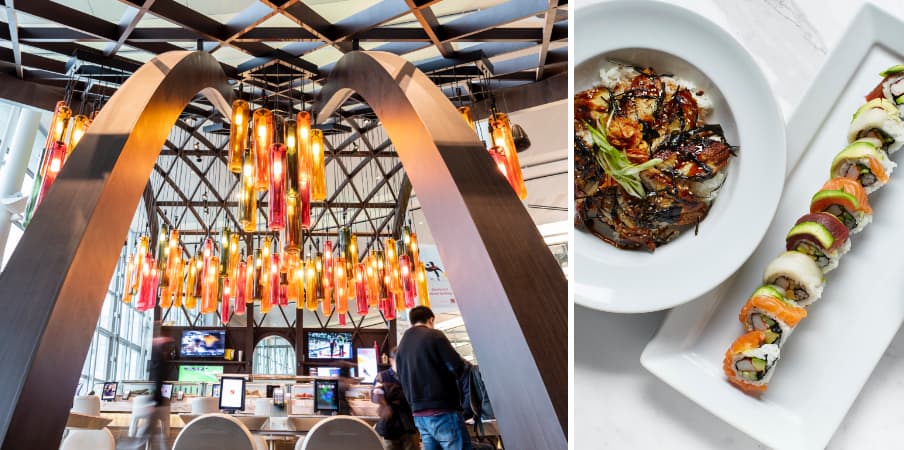Offering everything from whiskey and lipstick to umbrellas and memory sticks, Pearson’s many retailers contribute significantly to commercial (non-aeronautical) revenues, which over the past decade have been growing at a higher rate than total revenues. By offering a wide range of high-quality retail options, we attract more travellers who spend more in our terminals, growing net income – which we then reinvest (as a not-for-profit corporation) into further improving the passenger experience and our services to air carriers, while reinforcing our commitment to safety, security, sustainability and community building.
Keeping retail fresh and interesting requires constant innovation – not only in product selection and merchandising, but in how we work with retailers to create the best possible shopping experience.
Keeping retail fresh and interesting requires constant innovation – not only in product selection and merchandising, but in how we work with retailers to create the best possible shopping experience. Traditionally, airports’ commercial agreements with stores, restaurants and other concessions followed a landlord-tenant model. The more revenues generated by a tenant, the more an airport landlord would earn from rent and a percentage of sales.
 Pearson offers a wide range of high-quality retail options.
Pearson offers a wide range of high-quality retail options.
This simple approach yielded positive outcomes on both sides: higher store profits translated into higher rents. But it didn't reflect the complex changes sweeping through retail. Customers have become increasingly focused on service quality, relevant product assortment, store design – the whole shopping experience. And to fulfill those expectations, retailers have to gain more insights than ever about who is shopping in their stores, and why.
Recognizing these shifting trends, our Customer and Terminal Services team began looking at how we could collaborate more effectively with Pearson’s retailers to achieve common goals. Many of these conversations were transformative. To take one example: working with Dufry, which operates our duty-free stores, the GTAA’s retail team looked at data showing that some traveller segments representing a relatively small proportion of passenger traffic may actually account for a much higher percentage of duty-free sales. We were missing out on a proven opportunity with these shoppers by not offering more luxury fashion items.
Through whatever challenges lie ahead, we know that commercial revenue growth is an essential component of Toronto Pearson’s future financial sustainability.
Based on these and other insights, we significantly expanded our duty-free shops in both terminals, adding fashion and jewelry boutiques, as well as an expanded array of perfumes, cosmetics, and wine and spirits. Equally important, we worked closely with Dufry on everything from store design to optimizing customer flow.
 We significantly expanded our duty-free shops in both terminals, adding fashion and jewelry boutiques, as well as an expanded array of perfumes, cosmetics, and wine and spirits.
We significantly expanded our duty-free shops in both terminals, adding fashion and jewelry boutiques, as well as an expanded array of perfumes, cosmetics, and wine and spirits.
Underpinning this and many similar collaborations is a fundamental rethinking of how we structure commercial agreements with retailers, as we put passengers’ preferences and expectations front and centre. The result is a more enjoyable airport experience, with a measurable impact on the bottom line. We no longer see retailers simply as tenants working to maximize sales and yield steady returns for Toronto Pearson. We both invest in ways to better serve retailers’ most valuable customers – and we both benefit from the higher revenues that result.
Pearson’s management team has led the airport industry in forging senior-level relationships with some of the world’s best-known brands. Those efforts have paid off as we’ve achieved steady growth in sales and revenues. Through whatever challenges lie ahead, we’ll continue investing in more retail options, as well as dining and other amenities, because we know that commercial revenue growth is an essential component of Toronto Pearson’s future financial sustainability.
 Pearson airport restaurants offer anything from a quick bite to a healthy meal.
Pearson airport restaurants offer anything from a quick bite to a healthy meal.

For the third consecutive year, Toronto Pearson was ranked #1 in North America in the 2019 Airport Service Quality (ASQ) satisfaction survey conducted by Airports Council International. Our ASQ score of 4.48, the highest among all hubs serving over 40 million passengers annually, is a concrete measure of the commitment to passenger service reflected in our first-ever workforce survey and in the continued growth of the I am Toronto Pearson movement.








